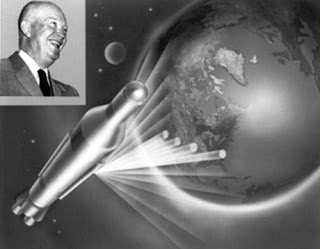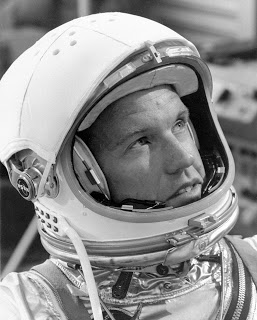 |
| The mad scientist as a young man. (Not George Krassner but, hey, it could have been.) Image from Beveled. |
Rocket science:
My brother’s keeper
“At age 29, as head of the Astro-Electronics Division, I had the civilian rank equal to a colonel, but I looked like a young kid. It was embarrassing to take them to lunch and be carded by the waiter.” — George Krassner
By Paul Krassner | The Rag Blog | August 28, 2013
When my brother George and I were kids, I could recite the alphabet backwards, whereas he read the entire dictionary. We both played the violin, and when he was nine and I was six, we performed at Carnegie Hall. (I was the youngest concert artist in any field to perform there.)
Our younger sister Marge took piano lessons and became a legendary figure at Boys & Girls High School in Brooklyn, teaching music and running the chorus. Now retired, she and two women — one plays the cello, the other a flute — have been booked to perform at the Salvador Dali Museum in St. Petersburg, Florida, playing music connected to various phases of Dali’s life.
Marge was the only one who stuck with classical music. Although I was considered a child prodigy, I merely had a technique for playing the violin, but I had a real passion for making people laugh. I put my violin in the closet when I was 12, and several years later I used it essentially as a prop when I began performing stand-up comedy.
George went to the High School of Music & Art, and was offered a four-year scholarship at the Juilliard School’s renowned Music Division, but he really preferred Math and Science. He surprised our family, announcing his decision to be an electrical engineer.
He turned down the scholarship and instead attended CCNY. “Because,” he says, “I thought then that the violin was good for my avocation, not my vocation. With so many brilliant musicians then, you really had to know somebody to get anywhere in that world. It’s not like YouTube today.”
While at CCNY, he played with a square dance group and became Official Fiddler for the New York/New Jersey Square Dance Callers Association. He learned that a caller earned twice as much as he did, so he put down his fiddle and took up calling square dances. He was also captain of the varsity boxing team.
George went to the University of Michigan for his Master’s Degree. Our mother insisted — and to please her — he mailed his laundry home in a light aluminum case she had purchased for that specific purpose. To pay for his tuition, basement apartment and other expenses, he got a teaching fellowship, was a research assistant, sold programs at football games, and bussed tables at a local restaurant, which he quit when the table he cleared was occupied by fellow students.
He won the all-campus boxing championship, but had to fight in a heavier weight class since no one else weighed as little as he did.
“Being a violinist, I was worried about my hands. But my opponent in the semifinal match was an oboe player with a concert scheduled for the next day, and he asked me to take it easy on his mouth.”
In October 1957, Russia sent Sputnik into space. It was the first orbiting satellite, circling the earth in 96 minutes, and making 1,440 orbits in three months. This astounding technical feat was totally unanticipated by the United States and ignited the era of the space race.
At the time, George was working as a civilian scientist for the Army Signal Corps in Fort Monmouth, New Jersey, in charge of the radio relay program. He had been recruited by their senior executive of Research & Development, an alumnus of the University of Michigan.
A week after Sputnik, George sent a proposal to the Commanding General, urging a space communication program. The response:Do it! “So,” George recalls, “I created the first Space Electronics organization in the country. It was very strange making presentations to generals and top government officials. At age 29, as head of the Astro-Electronics Division, I had the civilian rank equal to a colonel, but I looked like a young kid. It was embarrassing to take them to lunch and be carded by the waiter.”
That wasn’t his only embarrassment: “At the Signal Corps, I accidentally flushed my top secret badge down the toilet. It took a lot of official paperwork and the notation “irretrievably lost” to finally get a new badge. Also, in 1954, the McCarthy paranoia was paramount. I, and fellow civilians — and military personnel, I assume — had to empty our lunchboxes and briefcases for inspection every time we entered the building.”
Five months after he had begun as a civilian scientist, George was drafted. In the army, he was assigned to the 82nd Airborne Division at Fort Bragg in North Carolina. He was a “leg,” though. Instead of jumping out of an airplane, his job was to maintain all radios, phones, and electrical equipment. He also started the U.S. Helicopter Square Dance Team to demonstrate the mobility of helicopters. When assigned KP (Kitchen Police), rather than peel potatoes, he scheduled helicopter square dance practice.
Eight months after Sputnik, his team began working on the design of the world’s first communication satellite, SCORE (Signal Communications Orbit Relay Equipment). “There were no reference books, precedents, or Google for information. We were the pioneers. It’s interesting that the first known reference to communication satellites was in a 1945 science-fiction story by the British author, Arthur C. Clarke.” It took the team only six months to design and build the satellite, which was launched in December 1958 by an Atlas rocket that weighed 9,000 pounds.
“The satellite payload became famous for the tape-recorded message from President Dwight Eisenhower, who insisted that this project remain top secret,” George tells me. “He said the launch would be aborted if any word leaked out, because he didn’t want a chance of failure to tarnish our image. As it turned out, one of the two tape recorders did fail, but his Christmas message to the world was the very first transmitted message from space.”
Eisenhower stated: “This is the president of the United States speaking. Through the marvels of scientific advance, my voice is coming to you via a satellite circling in outer space. My message is a simple one. Through this unique means, I convey to you and all mankind America’s wish for peace on earth and good will toward men everywhere.”
 |
| The SCORE satellite carried Ike’s Christmas message. |
In 1945, in the wake of World War II, the victors launched Operation Paperclip, recruiting a variety of 600 scientists from Nazi Germany to work in the United States. President Harry Truman ordered the exclusion of any “member of the Nazi Party or an active supporter of Nazi militarism,” but the Joint Intelligence Objectives Agency created false employment and political biographies to circumvent Truman’s command.
Those scientists were then granted security clearance and infiltrated into hospitals, universities, and the aerospace industry, further developing their techniques in propaganda, mind control, and behavior modification. Among them was Wernher von Braun, who had been a member of the Nazi Party and an SS officer who could be linked to the deaths of thousands of concentration camp prisoners. (Fun fact: He married his cousin.) He came to America in 1945 and became a citizen in 1955. He was called the “Father of the U.S. space program.”
In June 1958, by the time those German importees had become entrenched in a slew of American niche communities, I published the first issue of my satirical magazine, The Realist, including a cartoon that depicted the U.S. Army Guided Missile Research Center with a sign in the window, Help Wanted. A couple of scientists are standing in front of that building, and one is saying to the other, “They would have hired me only I don’t speak German.”
Exactly one year later, Wernher von Braun recruited 13 scientists to work with him on an ultra-top-secret program, Project Horizon, to build a communication station on the moon. Its purpose was a study to determine the feasibility of constructing a scientific/military base. “I was one of the lucky 13,” George remembers. “In fact, you don’t have to be a rocket scientist to be a rocket scientist. Von Braun told me that many of his ideas came from science-fiction magazines.
“The project was so secret that the 13 of us could not even tell our bosses — they didn’t have what was called ‘need to know.’ I would tell [my wife] Judith that I was going to Washington, D.C., and then I would change planes to go to Huntsville, Alabama, where much of the work was done. I made up stories about Washington for her, while I really was in Huntsville, which also was the watercress capital of the world. Unfortunately, when I left the government after nine years (two in the army), I lost my own security rating and need-to-know, so I had no idea if the station was ever built on the moon, and I no longer got cheap watercress.”
According to Wikipedia, “The permanent outpost was predicted to cost $6 billion and become operational in December 1966. A lunar landing-and-return vehicle would have shuttled up to 16 astronauts at a time to the base and back. Horizon never progressed past the feasibility stage in an official capacity.”
“When I was assigned to work on top secret military and satellite work,” George tells me, “the FBI did routine checks. One of our neighbors told Judith that the FBI visited them but were told not to let us know of their inquiries. Apparently, you were on their ‘watch list’ — based on your ‘radical’ writings, I assume. I learned from my boss at the Signal Corps that my top-secret clearance was in jeopardy. Granting my clearance took about a month longer than normal, but eventually it was granted.”
Meanwhile, I was placed on the FBI’s RI (Round-up Index), though I had broken no law. Who knows, maybe it was because I published a cartoon depicting a man sitting at a desk, speaking on the phone: “I’m very sorry, but we of the FBI are powerless to act in a case of oral-genital intimacy unless it has in some way obstructed interstate commerce.”
When Life magazine ran a favorable profile of me, an FBI agent sent a poison-pen letter to the editor: “To classify Krassner as some sort of ‘social rebel’ is far too cute. He’s a nut, a raving, unconfined nut.” But in 1969, the FBI’s previous attempt at mere character assassination escalated to a more literal approach. This was not included in my own COINTELPRO (Counter-Intelligence Program) files but, rather, a separate FBI project calculated to cause rifts between the black and Jewish communities.
The FBI had produced a WANTED poster featuring a large swastika. In the four square spaces of the swastika were photos of Yippie (Youth International Party) founders Abbie Hoffman, Jerry Rubin and me, and SDS (Students for a Democratic Society) leader Mark Rudd. Underneath the swastika was this headline — LAMPSHADES! LAMPSHADES! LAMPSHADES! — and this message:
The only solution to Negro problems in America would be the elimination of the Jews. May we suggest the following order of elimination? (After all, we’ve been this way before.) *All Jews connected with the Establishment. *All Jews connected with Jews connected with the Establishment. *All Jews connected with those immediately above. *All Jews except those in the Movement. *All Jews in the Movement except those who dye their skins black. *All Jews. Look out, Abbie, Jerry, Paul and Mark!
(Shades of Wernher von Braun.)
It was approved by FBI director J. Edgar Hoover’s top two aides: “Authority is granted to prepare and distribute on an anonymous basis to selected individuals and organizations in the New Left the leaflet submitted. Assure that all necessary precautions are taken to protect the Bureau as the source of these leaflets. This leaflet suggests facetiously the elimination of these leaders.”
And, of course, if a black militant obtained that flyer and eliminated one of those “New Left leaders who are Jewish,” the FBI’s bureaucratic ass would be covered: “We said it was a facetious suggestion, didn’t we?”
On top of that, my name was on a list of 65 “radical” campus speakers, released by the House Internal Security Committee. The blacklist was published in The New York Times, and picked up by newspapers across the country. It might have been a coincidence, but my campus speaking engagements stopped abruptly.
When I wrote a piece for the Los Angeles Times, I titled it “I Was a Comedian for the FBI” because I had recognized a pair of FBI agents taking notes while I was performing at the Community Church in New York. (My FBI files later stated that I “purported to be humorous about the government.”)
The banner headline on the cover of the L.A. Times Sunday Calendar section blared out: Paul Krassner — “I Was a Communist for the FBI!” In the San Francisco Chronicle, columnist Herb Caen wrote, “Fearing Krassner would sue, the Times recalled and destroyed some 300,000 copies at a cost of about $100,000. Krassner would have laughed, not sued.” Or maybe I would’ve sued and laughed my ass off.
 |
| Dad ate Gordon Cooper’s cookie. |
By 1963, George had risen to Chief Scientist, Astro-Electronics Division at the Signal Corps, and McGraw-Hill contacted him, asking if he would write a book. And indeed, he began working on Introduction to Space Communication, which became the world’s first book on that subject.
“The problem was the incredible pace of technology,” he says. “While I was writing Chapter 5, the nuggets of wisdom in Chapter 2 were becoming obsolete. The last chapter was called ‘Ad Astra’ (Latin for ‘to the stars’), where I tried to forecast future technology. When the book was published in 1964, most of my future projections were already obsolete. Darwin had no idea about the speed of evolution when applied to technology. By the way, more copies of the book were sold in Russia than in the United States.”
On George’s last active project, he worked with the original seven astronauts. He was program manager at Simmonds Precision, responsible for the design of the fuel gauging system on the command module where the astronauts were housed.
In 1972, Apollo 17, the 11th manned mission, was the sixth and final lunar landing in the Apollo program. “We were on an extremely tight schedule, and my team worked nearly 80 hours with virtually no sleep to finish on time. We received a rare commendation and bonus from NASA for superior performance ahead of schedule and below budget.”
Gordon Cooper — one of those seven original astronauts — had piloted the longest and final Mercury space flight in 1963, becoming the first American to sleep in orbit. “He gave me a rare souvenir,” George now reminds me, “a dehydrated oatmeal cookie the size of a large dice that he had on a space mission.
During a family dinner, I passed around the cookie for everyone to see. Dad was hard of hearing and didn’t hear the story, so he popped the space cookie into his mouth, and it was gone before I could get any words out of my mouth. It was pure grief when it happened, but funny now.”
This article was first published at AlterNet and was cross-posted to The Rag Blog by the author.
[Paul Krassner edited The Realist, America’s premier satirical rag and was an original Yippie. Krassner’s latest book is an expanded and updated edition of his autobiography, Confessions of a Raving, Unconfined Nut: Misadventures in the Counterculture, available at paulkrassner.com. Read more articles by Paul Krassner on The Rag Blog.]

















